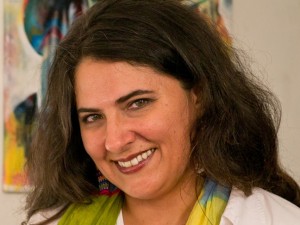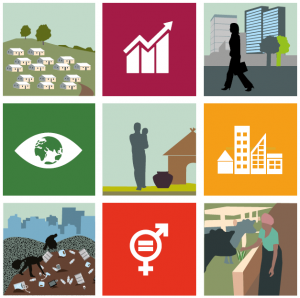What writers would you highlight to commemorate Women’s History Month? Comment below!

Image Source: suggestive celine (via Flickr)
March is Women’s History Month and an appropriate time to highlight some of the women’s voices that represent world literature. After all,
- American Hillary Clinton, who is an author of five books, is running for the U.S. presidency,
- Nigerian Chimamanda Ngozi Adichie, who is an author of five books, has a TED Talk that opens our courses concerned with social justice,
- and Pakistani Malala Yousafzai, author of one book, continues to fight for the equal education of girls and boys.
Check out these literary works from across the globe that engage discourses of women’s and gender rights in ways that are frequently subversive, occasionally confrontational, and always powerful.

Mahasweta Devi. Image Source: TopNews
“Draupadi” by Mahasweta Devi (1978)
Tags: India, South Asia, Bengali, short story
In a poor, post-colonial town in India, rumor has it that an infamous young woman, “Dopdi,” who has yet to reach the age of 30, has become a menace to local authorities. Fighting for labor rights and attacking officials without warning, she presents a dangerous local figure. Yet no one can identify her with any certainty. While the police have laid traps to draw her out of hiding in the forest, Dopdi continues to evade capture. In the end, what is meant to be Dopdi’s undoing invigorates her spirit and renders her an even more powerful threat. The best reading of this story is dependent on minimal research into the South Asian mythical epic of the Mahabharata. Themes of gender, sexual violence, and classism are strong threads in this short and powerful work. To continue the conversation addressing sexual violence as a world phenomenon and its prevalence in South Asia, attend the April 5th evening screening of India’s Daughter at the Spurlock Museum.
More Like This: Gayatri Spivak’s essay Can the Subaltern Speak? (India and postcolonial nations), most any title by Jhumpa Lahiri (India & the USA)

Gayatri Spivak. Image Source: Rosa Luxemburg-Stiftung on Flickr

Jhumpa Lahiri. Image Source: Il Circollo del lettori on Flickr
Nervous Conditions by Tsitsi Dangarembga (1988)

Tsitsi Dangarembga. Image Source: Pan American Center on Flickr
Tags: Zimbabwe, Africa, English, novel
In this novel, “Tambu” is a young girl living in a country then known as Rhodesia in the 1960s. Because she is female, her ambition for academic study is not well supported by her community—that is, until her older brother suddenly dies and someone must take on a role of leadership and status to save her family from economic ruin. As Tambu is introduced to a new world of privilege, knowledge, and experience, readers examine what she leaves behind and what these sacrifices mean in shaping a new, hybrid identity. This bildungsroman succeeds in taking on the ambitious goal of engaging discourses of gender, colonialism, and competing cultures in a work deemed one of the most important to have come out of Africa. If you are a current University of Illinois student and interested in these themes and this novel in particular, consider taking a course taught by Dr. Manisha Babb. She teaches a cross-listed course called Modern African Literature offered in the English, African Studies, Comparative World Literature, and French departments, respectively as ENG 470, AFST 410, CW 410, and FR 410.
More Like This: Mariama Bâ’s Une si longue lettre (Senegal), Maria Nsué’s Ekomo (Equatorial Guinea)

Mariama Bâ. Image Source: Wikipedia

Maria Nsué. Image Source: escritores.org
Emails from Scheherazad (2003) by Mohja Kahf

Mohja Kahf. Image Source: Aslan Media on Flickr
Tags: Syria, the Middle Eastern Diaspora, poetry
Do you remember Scheherazad(e)? She was the sole wife and queen to King Shahryar who eluded death by telling tales within tales that never ended? The stories of Aladdin, Sinbad, and Ali Baba all stem from this famous text. Mohja Kahf, a poet of Syrian descent, revisits this legacy in her compilation of poems. Emails from Scheherazad. Her bi-cultural identity informs and enriches her work, as seen in the poem “My Grandmother Washes Her Feet in the Sink of the Bathroom at Sears.” In it she describes being the product of both a Middle Eastern and an American culture. She regularly contradicts the widely held notion that being a Muslim and a woman is synonymous with being oppressed and her poems allude to globally recognizable female characters who face adversity—Eve, Malinche, Hagar, and more—suggesting a shared history and resilience. To get more connected to the local Muslim community on University campus, check out the United Muslims and Minority Advocates (UMMA) on Facebook.
More Like This: Arabian Nights/One Thousand and One Nights, Mona Eltahawy’s Headscarves and Hymens (Egypt & the USA), Ghada Abdel Aal’s I Want to Get Married (Egypt)

Mona Eltahawy. Image Source: Aspen Institute (via Flickr)

Ghada Abdel Aal. Image Source: Christopher Rose (via Flickr)
Yentl, the Yeshiva Boy by Isaac Bashevis Singer (1983)

Barbara Streisand as Yentl. Image Source: Ziegfeld Girl on Flickr
Tags: Poland & the Jewish Diaspora, Yiddish, short story
This text is actually written by a man. Because it inherently engages questions of genders and their roles in society, and also features a female protagonist, it remains relevant to global literature that tackles issues concerning women’s lives. The main character in this work, Yentl, has been spoiled by her father as a child by being allowed to study sacred rabbinical texts, an activity strictly reserved for men in her community. When her father dies, not wanting to abandon her religious learning, she makes a plan to hide her sex and continue on her path of erudition. However, there are some unanticipated expectations associated with her new role as a male. The cinematic adaptation of Yentl starring Barbara Streisand is inextricably linked to this literary work. If you’re an enrolled student and interested in this area, seek out the Program in Jewish Culture & Society for more about works written in Yiddish and on the Jewish diaspora. A selection of the program’s courses can be found on the program’s website.
More Like This: Anne Frank, The Diary of Anne Frank, Deborah Feldman’s Unorthodox: The Scandalous Rejection of My Hasidic Roots

Anne Frank. Image Source: Wikimedia Commons

Deborah Feldman. Image Source: Zimbio
“Kinsey Report” by Rosario Castellanos

Rosario Castellanos. Image Source: Milagros Mata Gil (via Flickr)
Tags: Mexico, Latin America, Spanish, poetry
The title of this poem refers to American sexologist Alfred Kinsey, whose published works on human sexual behavior became well known in the mid to late 20th century. While this poem makes for a quick read, it remains in the reader’s memory indefinitely. It features six different feminine voices that expound on the condition of their gender. One woman reports on her marriage which has become a hollow and juridical union of self-sacrifice and anxiety; another fears being deemed a prude for lack of sexual activity or a whore for any carnal intimacy engaged outside of marriage; a third wistfully awaits a Prince Charming who will whisk her away from any care she might have. All of the voices problematize notions of female gender and show how societal expectations and traditional roles can, to say the very least, be limiting. For ways to find more Latin American literature, see this lib guide.
More Like This: All titles by Sor Juana Inés de la Cruz (Mexico), all titles by Clarice Lispector (Brazil), Sabina Berman’s (Mexico) Entre Villa y una mujer desnuda

A drawing of Sor Juana Inés de la Cruz. Image Source: Wikipedia

Clarice Lispector. Image source: ana.claudia (via Flickr)
Happy reading, sharing, and happy Women’s History Month! Let us know what additional authors you would add to this conversation. Also drop by the Main Library’s Marshall Gallery (first floor, east side of the building ) to see an exhibit curated by Leanna Barcelona highlighting women’s history at the University of Illinois. If you want even more titles, visit the Undergraduate Library’s post to commemorate Women’s History Month last year.
For more posts like these, make sure to like our Facebook page, where we share a new Glocal Notes article every week of the semester.


























